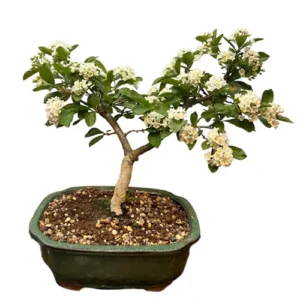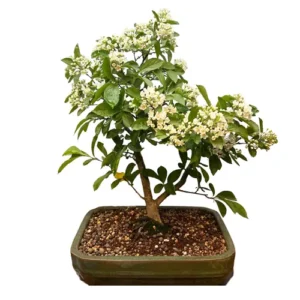Cotinus Coggygria
Smoke Tree Bonsai
This branching deciduous shrub is part of the cotinus species, native to the higher altitude regions of South Europe, and Central Asia, all the way up to Northern China. In Autumn, its leaves produce a stunning array of colours including yellow, orange, pink, scarlet and peach, creating a smoky visage. Its leaves produce a radish-like fragrance when broken.
Smoke Tree Bonsai Care Tips
Placement
Smoke Tree Bonsai demand full sun across the growing season a minimum of 6 hours of sunlight. Middling temperatures and moderate humidity suit. If you expect temperatures below -5 °C, consider moving it to an unheated greenhouse, conservatory or providing insulation for the pot.
Watering
Younger Smoke Tree Bonsai require deep and regular watering. However once matured, this specimen is considerably resistant to drought. Across the growing season, a mature plant requires watering once every ten days.
Feeding & Fertilising
The feeding requirements of Smoke Tree bonsai are reasonable. Across the growing season from spring till early autumn, this species needs feeding once every two weeks.
Pruning & Wiring
As the foliage grows fast, trimming is a regular requirement to stop the plant from drooping. Any dead and damaged wood should be removed. Pruning branches should take place in the early spring. Smoke Tree Bonsai are tolerant to robust pruning and to keep the shape of the plant this should be done regularly.
Smoke Tree’s thin bark means special care is required when wiring. We recommend using wires with a thickness that matches the thickness of the branch: if the wire you choose is too thick you will damage the bark. If it is too thin, it won’t be effective.
Repotting
Repotting your tree is an important way to provide a fresh and suitable soil mix and ensure appropriate root health. Smoke Tree Bonsai require repotting once every two years in early spring. This is one of the easier bonsai plants to repot due to its tough root system.
Trees that are ready for repotting will require root pruning, a suitable new pot and appropriate soil mix.
When repotting, do not cut back the root mass by a large amount, and choose a well-draining soil mix that has a neutral or slightly higher PH value of 5-6 but not over 7. We tend to use a mixture of different speciality bonsai soils on our trees. Every species is different so please contact us for free soil-mix advice or to take advantage of our repotting service.
Bonsai trees aren’t only magnificent additions to an indoor oasis, they are more than capable of standing out in any garden. Many Bonsai species are incredibly hardy and withstand nature’s colder and damper turns with aplomb making them worthwhile outdoor plants. We have an extensive library of care guides for outdoor bonsai trees. It’s not about selecting the perfect bonsai, it’s about selecting the perfect bonsai for you.
Smoke Tree Bonsai - Typical Queries
Are Smoke Tree bonsai toxic?
Smoke Tree bonsai require special handling as they are poisonous to humans. When working on your Smoke Tree bonsai its advised to where protective gloves as the sap can cause skin irritation.
How to propagate Smoke Tree Bonsai?
Smoke tree bonsai can be propagated with seeds cuttings or layering. Seeds need soaking in water for a day and a night and air drying before sowing. Sow seeds in autumn. Layering should be done in Spring. Softwood cuttings are to be taken in the summer.
Do Smoke Tree Bonsai get pests and diseases?
Smoke Tree bonsai can incur verticillium wilt, which will brown the leaves and if left unaddressed will cause entire branches to droop before dying. This is easily avoidable by using soil that can drain properly. Purple Smoke Trees can suffer from mildew.





















